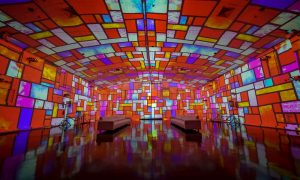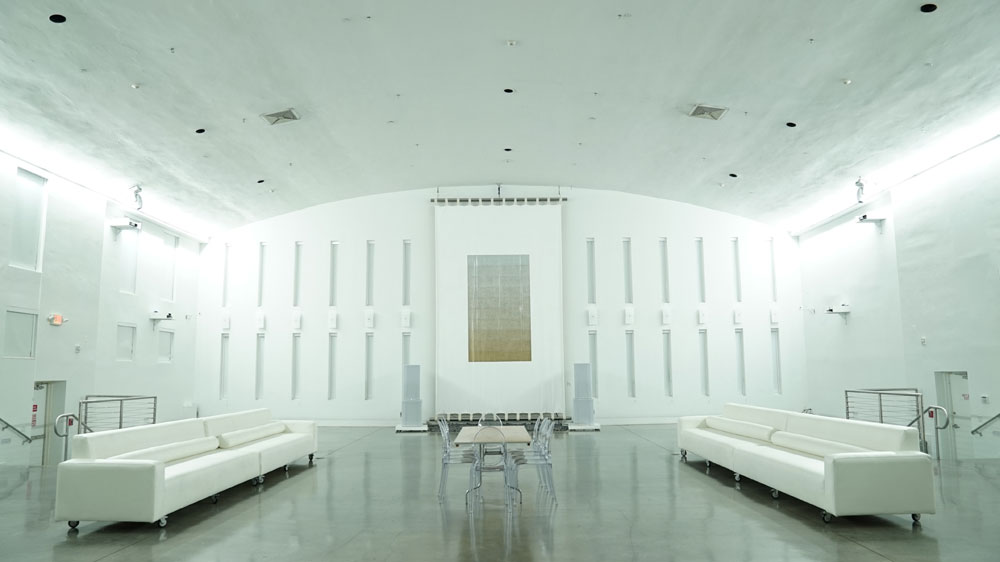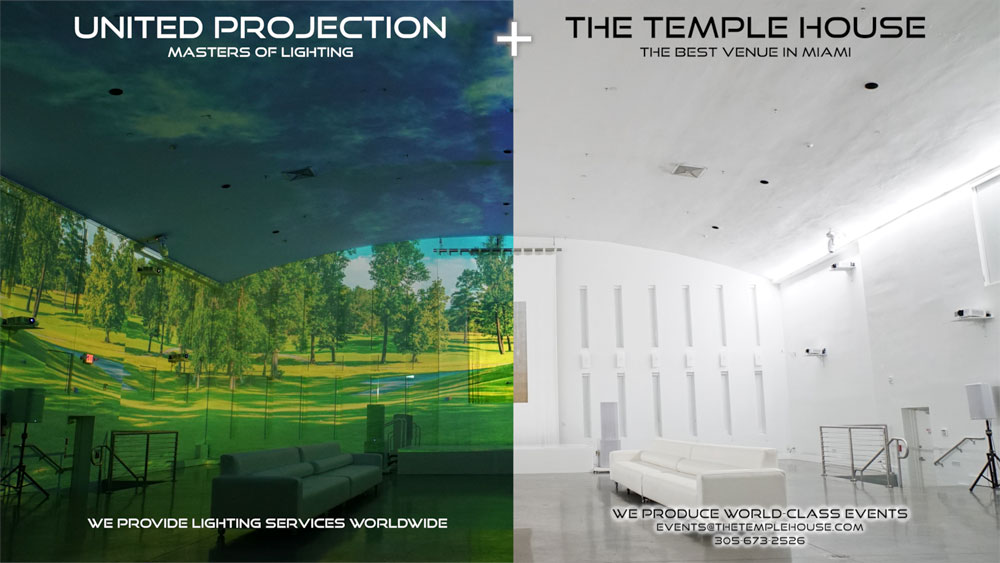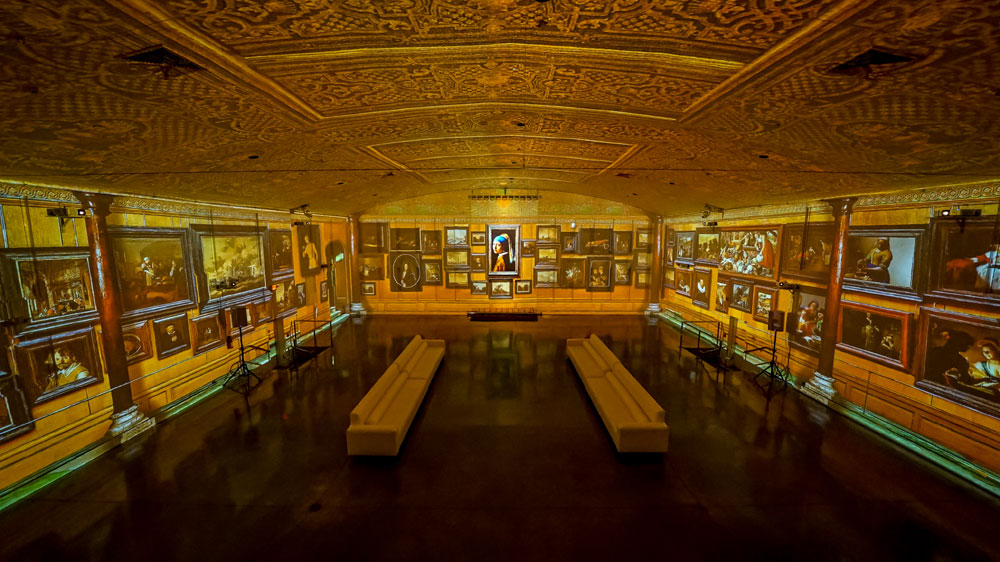Projection mapping is changing the ways bars can interact with customers. In the age of COVID-19 where most people are limiting their travel, your bar can bring the experience of travel to your customer. Throw a party in a Moroccan market or by the Eiffel Tower at sunset, or make guests feel like they’re sipping cocktails by the ocean—it’s all possible with projection mapping.
 Below is a case study illustrating how Daniel Davidson and his company, United Projection, create virtual, immersive environments within the walls of their venue in Miami Beach, and in conference centers, hotel ballrooms, private homes and adaptive re-use properties around the world.
Below is a case study illustrating how Daniel Davidson and his company, United Projection, create virtual, immersive environments within the walls of their venue in Miami Beach, and in conference centers, hotel ballrooms, private homes and adaptive re-use properties around the world.
Since their first mapping event in 2016, Davidson and his team have relied on Epson projectors to make these immersive environments a reality. Yet as the technology evolved, they too have made changes, moving to a combination of Epson Pro L610 and LightSceneEV-100 laser projectors.
The Temple House
Davidson, who describes himself as a “serial entrepreneur,” began his latest venture by purchasing an adaptive re-use property that became both his “light” research laboratory and home in Miami Beach in 2003.
The Temple House, originally built in 1934 then expanded for use as a synagogue, became the largest single-family residence in South Beach. Together with its size, its beautiful Art Deco style made it remarkably attractive for entertaining.
In addition to serving as his 16,000-square-foot home, the unique property became Davidson’s research laboratory where, by both exploring and applying a variety of different emerging technologies, he has been able to establish a leadership position in the field of projection mapping.

By 2012, Davidson had received permits to use his home as a venue for private events, such as weddings, banquets, Bar-Mitzvahs, charity galas, video productions, and corporate parties. “I host amazing celebrity events and launch many luxury consumer products and vehicles,” he explains. “They are all very exclusive, private invite-only and not open to the public, so the venue has become one of the most desirable locations for a highly select and very sophisticated audience.”
The Temple House, as Davidson named it to respect its 70+ year history, includes a 60-by-80-foot Grand Room with 24-foot ceilings and a large balcony as an ideal VIP area. It also includes a large rooftop terrace, and smaller spaces which he converted into private dining and conference rooms, green rooms, a couples suite, and a catering kitchen, as well as his own residence.
“A Mykonos style outdoor space is not visible from the street, so it has become the place for celebrities to hang out and have total privacy,” he says. “Almost every event takes advantage of the outdoors, whether under the spectacular blue Miami skies or a warm moonlit night.”
In 2016, Davidson formed a new company, United Projection, to serve the growing interest in projection mapping, whether in The Temple House or other venues. Because the environments the company creates are all custom, this company had to include artistic talent as well as technical.
“United Projection has assembled an award-winning team of projection mapping specialists, visual and motion graphic artists, audio specialists, and lighting designers who produce jaw-dropping, mind-blowing, stunning 360-degree visually immersive environments,” he explains.

Today, the company includes seven full-time employees, 15 regular freelancers, plus over 100 additional contract employees specializing in projection mapping, as needed, in Asia, Europe, Central and South America.
“The Temple House is a perfect projection canvas, and now serves as a showcase for other property owners to see first-hand how United Projection and Epson can transform any four walls into the next generation of experiential spaces. The ROI more than justifies the investment.”
A new production company
Davidson says that, while he used Epson for his first mapping event, he did not necessarily plan to focus on the brand exclusively. “We tested a lot of projectors, evaluated the specs, field tested, did projector ‘shoot outs’ and interviewed reps from various companies. We kept coming back to Epson because Epson won every time. The product line is excellent.” He further said, that “United Projection is on the leading edge of projection mapping, and we cannot and will not settle for anything but the best.”
Eventually he and his team mounted 14 Epson Pro G Series projectors within the Grand Room, purchasing a few extras as well that they could use to augment the primary system.
Although all are wall-mounted, several are angled up to project on the ceilings with extra units to project on the floors as well.
When Epson introduced its Pro L615U laser projector in February 2018, Davidson upgraded. He felt the virtually maintenance free laser light source with no lamps1would be ideal for the work at hand. In the fall, he added a number of Epson LightSceneEV-100 accent lighting laser projector, and he plans to buy more.
In addition to the projection systems, United Projection has an inventory of media servers, video and audio amplifiers, video processors, loudspeakers, and accessories. “We created a suite of intellectual property, as well as custom designed applications to integrate all of the elements unique to our system. Great people, great technology, great vision, great creative talent and seamless integration,” he adds.
All of this equipment can be taken on the road, although mapping for a new venue requires very careful planning. “Every event with projection mapping is memorable, because they are all so unique and different!” Davidson explains. Ariel Glassman, Creative Director of United Projection says, “Some of the most exhilarating visual shows have been for private cocktail and album release parties, with performances by Shakira, Kesha, Tiestoand Ozuna, to name a few.
“We also love when brands utilize the projection to get super creative with their branding and do amazing things with the visuals that they can’t do anywhere else. Car and product launches, for example, are extraordinarily cool. Fortune 500 companies demand the absolute best for high-profile media events and product launches. Epson gives us the peace of mind and allows us to focus 100 percent on unique content delivery.”
Enter the LightScene
Not every visual Davidson and his team creates is projection mapped. They have set up projectors and screens in the conference rooms, suites, lobbies, and even on the rooftop terrace for evening events. For many of those applications, the Epson LightScene offers significant advantages over traditional systems.
The product is unique in that it combines a 2,000-lumen laser projector with the format of an oversized track lighting fixture, able to function as a projector, a spotlight, or both at once. Like a track light, it’s easy to aim the LightScene almost anywhere, on a screen, on a wall, ceiling or floor, or to map onto a 3D object. Like other projectors, it has HDMI and Ethernet connections, but it also includes its own content management system, able to run multiple video or still image playlists from an SD card.
“One way we have used the LightScene is to project on a semi-translucent curtain that can divide the Grand Room,” Glassman says. Here the content management system functions like a gobo, a slide traditionally placed in front of a theatrical light fixture to project a shape or logo.
“The LightScene units are so tremendously versatile we have explored using them virtually everywhere,” he adds, “One of our chief challenges is to get our team on the same page, as everybody has their own creative and magical ideas for the LightScene units.”

A sea change
Moving forward, Davidson expects exponential growth and evolution in the use of projection mapping.
“What we see and anticipate is a wide-scale recognition by progressive designers and architects to integrate these systems early on in the design of buildings. This is setting the stage for the technology to become more widespread and common in places that we may never have anticipated. Affordable, high-quality technology of this type is creating a sea change in the applications of this phenomenal technology.”








